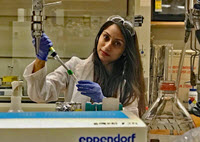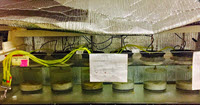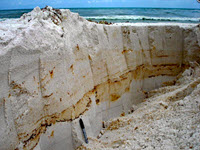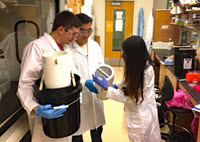
Petroleum hydrocarbons released by oil spills can accumulate on beaches and in nearshore sediments, potentially creating health risks for humans and coastal organisms. However, the highly variable conditions of beach environments make it difficult to determine the long-term behavior and fate of hydrocarbons in sands and sediment. Smruthi Karthikeyan combines bioinformatics and oil degradation data to examine microbial responses to oil in beach environments and identify populations that act as bioindicators of oil degradation and toxicity. Documenting microbial indicators and producing oil degradation models for environmental managers can help with future oil spill response plans for coastal zones.
Smruthi is a Ph.D. student with the Georgia Institute of Technology’s School of Civil and Environmental Engineering and a GoMRI Scholar with the project A Systems Approach to Improve Predictions of Biodegradation and Ecosystem Recovery in Coastal Marine Sediments Impacted by Oil Spill.
Her Path

Smruthi grew up in Chennai, India, near one of the largest beaches in the world, which sparked her interest in environmental health. Later, she completed an undergraduate chemical engineering program at Anna University because of its practical applications. She then transitioned to Columbia University for her master’s environmental engineering studies, which she considers an ideal interdisciplinary field that unites science and technology. “Being in the environmental engineering field gives me a lot of opportunities to view the environment from different perspectives,” she said.
Smruthi’s Ph.D. advisor Dr. Kostas Konstantinidis introduced her to the microbial world during one of his classes. She was intrigued about using bioinformatics to elicit information from such tiny creatures and was curious about the microbial role in environmental pollutant biodegradation. Konstantinidis received GoMRI funding in 2016 to research how microbes respond to oiling and identify indicator species for oil degradation and toxicity in beach sands. Accepting a position on his team made Smruthi excited about combining her love of environmental preservation with microbial genomics.
Her Work

Smruthi conducts laboratory mesocosm experiments that mimic the in situ conditions found in the beach environment. She incubates Pensacola beach sand collected at different times during the Deepwater Horizon incident in six acrylic chambers (three with oiled sand and three with pristine sand) and replicates the tidal cycle by periodically adding and removing water overlying the sand. While sensors monitor pH, oxygen, nutrient, and temperature levels inside the chambers, she collects sand samples at designated time intervals and analyzes the microbial community’s DNA and RNA.
“Thanks to recent developments in cultivation-independent and next-generation sequencing methods, we are able to see microbial communities at a much higher resolution than ever before and identify their activities and nutrient limitations,” said Smruthi. “We can answer not only ‘Who is there?’ but also ‘What are they doing?’ from less than a gram of sand sample.”

Smruthi’s analyses identify microbial populations with reduced abundance after oil exposure and observe if they return after oil is completely removed. Populations that do not return could warrant further investigation to assess how long it may take an ecosystem to recover after oiling. Her analyses also examine the gene content of individual microbial populations and compare them to hydrocarbons used in the experiment to determine which oil-degrading genes the microbes possess. A microbe that is more abundant after oil exposure may be a viable bioindicator of oil presence and biodegradation processes. Smruthi hopes that comparing her microbial data to the in situ sensor data can help develop an integrated conceptual model that allows predictions of pathways and oil degradation rates needed for future forecasts of recovery pathways.
Smruthi’s analyses have revealed a previously undiscovered microbial genus that was below detection in clean sands but rapidly increased to 30% of the total microbial community in oiled sands. According to publicly available databases, the species appears consistently in oil-contaminated sediments worldwide, particularly as a responder to other major oil spills, while being notably absent in unoiled environments. The microbe is metabolically versatile and can feast on oil and get the nitrogen it needs from the atmosphere, eliminating the need to add potentially harmful fertilizers that encourage microbial oil degradation. “It appears that this microbe belongs to a new genus of keystone oil degraders that has gone unnoticed so far and thus could represent a new model organism for oil bioremediation efforts,” said Smruthi. “We proposed to name this new bacterial genus “Macondimonas,” as we recovered it from the Macondo oil spill.”
Her Learning

Smruthi’s experiences conducting GoMRI research opened her eyes to many different perspectives of oil spill research. Working with her advisor and their project’s principal investigator Dr. Markus Huettel helped her see the multifaceted aspects of her research, while interacting with scientists from different disciplines broadened her scientific perspective. “As someone who did not have a background in computational biology and marine ecology initially, this GoMRI grant has greatly helped my venture into this new and fascinating area,” she said. “It showed me that there’s a whole new realm out there filled with these microscopic marvels while at the same time integrating my engineering background.”
Her Future
Smruthi hopes to become a professor after completing her Ph.D. She encourages students considering a career in science and technology by telling them, “It is a rewarding and satisfying experience to actually see that your work can someday help the environment and society in whatever little way it can.”
Praise for Smruthi
Konstantinidis said that Smruthi is a hard worker with strong analytical abilities and a tremendous capacity and desire to learn new things. Her contributions helped his team explore new research ideas that resulted in important discoveries, such as the new oil-degrading bacteria. “[Our work with Smruthi] happened due to a bit of good luck,” he said. “When the advisor that Smruthi was working with initially decided to retire, I talked to Smruthi about the GoMRI project, and she got really excited and wanted to join our research team. It was good luck for all of us, I think!”
The GoMRI community embraces bright and dedicated students like Smruthi Karthikeyan and their important contributions. The GoMRI Scholars Program recognizes graduate students whose work focuses on GoMRI-funded projects and builds community for the next generation of ocean science professionals.
************
The Gulf of Mexico Research Initiative (GoMRI) is a 10-year independent research program established to study the effect, and the potential associated impact, of hydrocarbon releases on the environment and public health, as well as to develop improved spill mitigation, oil detection, characterization and remediation technologies. An independent and academic 20-member Research Board makes the funding and research direction decisions to ensure the intellectual quality, effectiveness and academic independence of the GoMRI research. All research data, findings and publications will be made publicly available. The program was established through a $500 million financial commitment from BP. For more information, visit https://gulfresearchinitiative.org/.
© Copyright 2010-2018 Gulf of Mexico Research Initiative (GoMRI) – All Rights Reserved. Redistribution is encouraged with acknowledgement to the Gulf of Mexico Research Initiative (GoMRI). Please credit images and/or videos as done in each article. Questions? Contact web-content editor Nilde “Maggie” Dannreuther, Northern Gulf Institute, Mississippi State University (maggied@ngi.msstate.edu).
